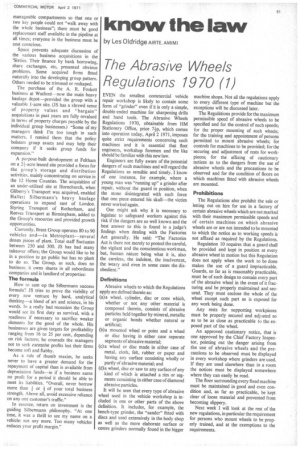know the law
Page 53

If you've noticed an error in this article please click here to report it so we can fix it.
by Les Old ridge AIRTE, AMIMI
The Abrasive Wheels Regulations 19 70 (1)
EVEN the smallest commercial vehicle repair workshop is likely to contain some form of "grinder" even if it is only a simple, double-ended machine for sharpening drills and hand tools. The Abrasive Wheels Regulations 1970, obtainable from HM Stationery Office, price 74-p, which comes into operation today, April 2 1971, imposes quite strict requirements concerning such machines and it is essential that fleet engineers, workshop foremen and the like should be familiar with this new law.
Engineers are fully aware of the potential dangers of such machines and will regard the Regulations as sensible and timely. I know of one instance, for example, where a young man was "running up" a grinder after repair, without the guard in position, when the stone disintegrated with such force that one piece entered his skull—the victim never worked again.
One might ask why it is necessary to legislate to safeguard workers against this risk if the dangers are so well known and the best answer to this is found in a judge's findings when dealing with the Factories Act generally. He said: "The Factories Act is there not merely to protect the careful, the vigilant and the conscientious workman, but, human nature being what it is, also the careless, the indolent, the inadvertent, the weary and even in some cases the disobedient."
Definitions Abrasive wheels to which the Regulations apply are defined therein as: (a)a wheel, cylinder, disc or cone which, whether or not any other material is composed therein, consists of abrasive particles held together by mineral, metallic or organic bonds whether natural or artificial; (b)a mounted wheel or point and a wheel or disc having in either case separate segments of abrasive material; (c)a wheel or disc made in either case of metal, cloth, felt, rubber or paper and having any surface consisting wholly or partly of abrasive material; and (d)a wheel, disc or saw to any surface of any kind of which is attached a rim or segments consisting in either case of diamond abrasive particles.
It will be seen that every type of abrasive wheel used in the vehicle workshop is included in one or other parts of the above definition. It includes, for example, the bench-type grinder, the "sander" fitted with discs and used extensively in the body shop as well as the more elaborate surface or centre grinders normally found in the bigger machine shops. Not all the regulations apply to every different type of machine but the exceptions will be discussed later.
The Regulations provide for the maximum permissible speed of abrasive wheels to be specified and for the control of such speeds; for the proper mounting of such wheels; for the training and appointment of persons permitted to mount abrasive wheels; for controls for machines to be provided; for the securing and adjustment of rests for workpieces; for the affixing of cautionary notices as to the dangers from the use of abrasive wheels and the precautions to be observed and for the condition of floors on which machines fitted with abrasive wheels are mounted.
Prohibitions The Regulations also prohibit the sale or letting out on hire for use in a factory of certain abrasive wheels which are not marked with their maximum permissible speeds and of certain machines on which abrasive wheels are or are not intended to be mounted to which the notice as to working speeds is not affixed as required by the Regulations.
Regulation 10 requires that a guard shall be provided and kept in position at every abrasive wheel in motion but this Regulation does not apply when the work to be done makes the use of a guard impracticable. Guards, so far as is reasonably practicable, must be of such design to contain every part of the abrasive wheel in the event of it fracturing and be properly maintained and secured. They must enclose the whole of the wheel except such part as is exposed for any work being done.
Any rests for supporting workpieces must be properly secured and adj.isted so as to be as close as practicable to the exposed part of the wheel.
An approved cautionary notice, that is one approved by the Chief Factory Inspector, pointing out the danger arising from the use of abrasive wheels and the precautions to be observed must be displayed in every workshop where grinders are used. If they are used elsewhere than in a room the notices must be displayed somewhere where they can easily be read.
The floor surrounding every fixed machine must be maintained in good and even condition and, as far as practicable, be kept clear of loose material and prevented from becoming slippery.
Next week I will look at the rest of the new regulations, in particular the requirement for persons who mount wheels to be properly trained, and at the exemptions to the requirements.




























































































